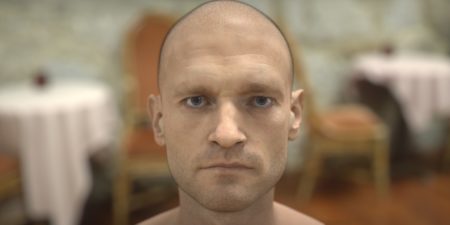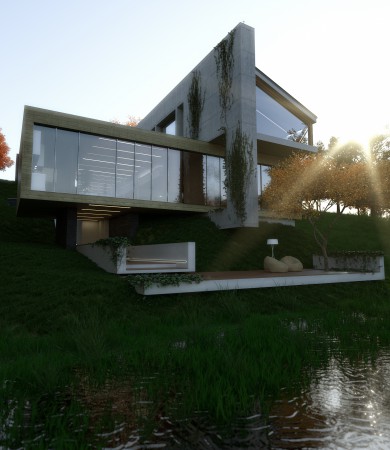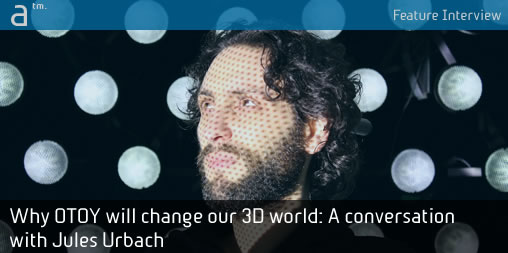Everyone once in a while a very bright and tremendously driven young person comes up within the computer software industry—in time introducing something that will change our world. Jules Urbach may just be one of those people. Except, he’s not entirely that young anymore. Fortunately for me my iPad’s note taking app has a digital recorder, which I completely had to rely on to keep up with a 39 year-old Urbach who—if you didn’t know any better—you would assume is another fast-talking, techno-skater wunderkind happily enjoying the glory of Silicon Valley.
Yet, Jules Urbach isn’t in Silicon Valley—and for good reason. And he’s not a young Bill Gates or Mark Zuckerberg—though like both of those tech stars he too was once a Harvard bound kid who bailed on the comfort and retreat of cozy, ivy-layered quads for self-induced, caffeine enriched late-night solo coding sessions. Those sessions of course led the young Jules to create the hit game “Hell Cab” for Time Warner while in his teens. He later pushed gaming tech towards more realism and onto the Net into what we now refer as the cloud.
But for the past ten or so years Jules Urbach has been perfecting a digital recipe for both leveraging the massive computational power of the standard GPUs inside servers on the cloud as well as devising a way to compress intensely realistic imagery—which is typically massive in file size—down to something that can literally stream over the Net just like your favorite YouTube video. And with all of this comes several sets of almost magical promises for the future, including—and quite importantly for our readers—the ability to run just about any complex 3D application on any platform, on any device and remotely over the Internet. If this happens—and there is a very good chance it will—every industry from architecture, industrial design to computer gaming and Hollywood Blockbusters will be affected.
Sound exciting? How about interesting?
We think this is very important. And so I sat down virtually with Jules Urbach a few weeks ago to chat about all of this transformative technology his company OTOY is up to. What follows are the highlights of our conversation.
The Emergence of OTOY
AFR (Anthony Frausto-Robledo): So tell me, what are you focused on, what keeps you up at night and what do you love?
JU (Jules Urbach): I love this work. OTOY was really built around graphics—even the streaming stuff we do with the cloud—it all stems from the GPU. Literally every product we’ve done has some connection to the GPU. The coder and decoders all run on pixel shaders. We want to be a part of making graphics for the better!
AFR: How did you personally get started with computer graphics?
JU: I always wanted to work on films and games. My first job was working for Time Warner on “Hell Cab” in ’93. I got into Harvard and I just dropped out. I never went back—so I could do that game. I was focused on video games up until around ’96, then I started to focus on streaming games and then improving the rendering in game engines. Then I realized you could get raytracing to run on GPUs—and also the whole complex shader pipeline for “final renders” to also work on GPUs—and that’s when things got really exciting.

01 – Human skin and hair are some of the hardest items for software rendering engines to replicate accurately. Octane Render technology does a very admirable job in this image render.
Okay, so I want to do a game engine and a final render engine that basically have a shared core. And I want to do it on the cloud where compute power isn’t even an issue. And that really was the genesis of OTOY today; those vectors led me there.
So as we’ve been building and testing various pieces we have also done work on films, like Transformers, and games for Hasbro and others—testing and improving both. Soon the streaming became a really big part of what we were doing.
AFR: And where are we in time when this sequence emerged?
JU: That came together around 2009. And that’s when OTOY, as a company, really started to form and when we got our first investment in.
AFR: When did you begin partnering with Autodesk?
JU: Well our largest partner on the streaming side is Autodesk, who came to us about four years ago—ideally to help them build a web-based framework to allow them to deliver their applications and forward-looking services, remotely, and to have us work on those pieces. And shortly after that Octane came to market as the first “final render” quality GPU renderer. And since then we have basically been involved on all those various pieces.
And…yeah! That’s basically how this all came to be, but there is more on the business side.
Harvard, You’re Not “New” Enough
AFR: Okay, we can do the business side later. But first I want to know about your earlier roots, as I understand that you dropped out of Harvard. Where did you learn programming if not in college? You are a programmer, right?
JU: Yeah, I’m self-taught. I took some courses in high-school but I wanted to do things a totally different way. They weren’t focused on graphics really, where I was taking classes; and at Harvard I was interested in the cross-enroll with MIT because—of course—they have the Media Lab. But none of that stuff was new.
The point was if they actually taught it it wasn’t going to be new and innovative. And I wanted to just totally create stuff from scratch. And a lot of the stuff that I did, that led up to OTOY, really even started back in the video game world. I tried to do streaming and getting games to run in the cloud—and all that stuff happened in the early and mid ’90’s.

02 – OTOY purchased Octane Render because it added logical value to OTOY’s biggers quests in graphics technology. Octane can do full GPU raytracing in an “unbiased” manner. (image courtesy of OTOY. Photo credit: KXL Architects. All rights reserved.)
So yeah, I taught myself everything. I taught myself how to program GPUs, program in C++. And that is just how I learned to progress. I don’t do nearly as much programming now. Thankfully there is a team that has been able to pickup a lot of the pieces, but pretty much up until 2010, a huge amount of the work of everything we did was done by me. And it was good, it helped set a lot of the frameworks we have in place, now that we are a larger company.
AFR: So I think I got this right, help me out here now…but I think it was around 2010 or 2011 that Octane Render had its coming out party of sorts…that’s when OTOY emerged.
JU: It ended up being that way but it was almost an accident—because Octane was a product that we brought into OTOY. It was created by the guy who created LuxRender, Terrance Vergauwen; and I think he literally spent months alone building the product and basically when we acquired it we put a team around it. But he put it out there on a website around 2010 and one of our guys immediately saw it and we were pretty excited by it and I immediately wanted it to be a part of OTOY.
AFR: Why?
JU: It is a very different way of rendering. I had already been doing GPU-based raytracing in a “biased” way; Terrance had done it in an “un-biased” manner and that’s why I felt we needed it—it was a great complement to what we were doing, especially to finally crack the “final render” piece on the GPU side. I think we announced it [the acquisition] officially in 2011 and it became part of OTOY in 2012.
next page: Move Over OpenGL and DirectX—Meet the New “Brigade”
[title image: Jules Urbach inside OTOY’s Light Stage technology. Image courtesy of OTOY Inc., All rights reserved.]




Reader Comments
http://t.co/jf8xpWzluH Architosh talks to Jules Urbach of @OTOY about his company’s GPU-based transformative technology. Read on!
#CAD Why OTOY will change our 3D world: A conversation with Jules Urbach http://t.co/cbKBpJd0qA
RT @architosh: http://t.co/jf8xpWzluH Architosh talks to Jules Urbach of @OTOY about his company’s GPU-based transformative technology. Rea…
http://t.co/jf8xpWzluH Architosh talks to Jules Urbach of @OTOY about his company’s GPU-based transformative technology. Read on!
http://t.co/jf8xpWzluH — Jules Urbach of OTOY fame talks about his company’s partnership with Autodesk. All in the interview—read on!
http://t.co/jf8xpWzluH — Jules Urbach of OTOY fame talks about his company’s partnership with Autodesk. All in the interview—read on!
#CAD Why OTOY will change our 3D world: A conversation with Jules Urbach http://t.co/cbKBpJd0qA
RT @architosh: http://t.co/jf8xpWzluH Architosh talks to Jules Urbach of @OTOY about his company’s GPU-based transformative technology. Rea…
RT @architosh: http://t.co/jf8xpWzluH Architosh talks to Jules Urbach of @OTOY about his company’s GPU-based transformative technology. Rea…
RT @architosh: http://t.co/jf8xpWzluH Architosh talks to Jules Urbach of @OTOY about his company’s GPU-based transformative technology. Rea…
RT @architosh: http://t.co/jf8xpWzluH Architosh talks to Jules Urbach of @OTOY about his company’s GPU-based transformative technology. Rea…
Why OTOY will change our 3D world: A conversation with Jules Urbach | Architosh http://t.co/pu0tfwweTd
Why OTOY will change our 3D world: A conversation with Jules Urbach | Architosh http://t.co/pu0tfwweTd
Resistance is futile. http://t.co/1ZIRZhOtaa
Resistance is futile. http://t.co/1ZIRZhOtaa
Comments are closed.